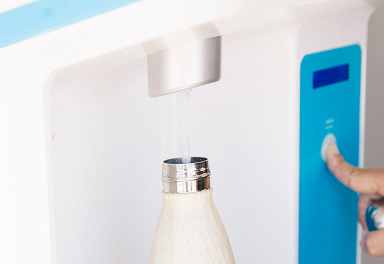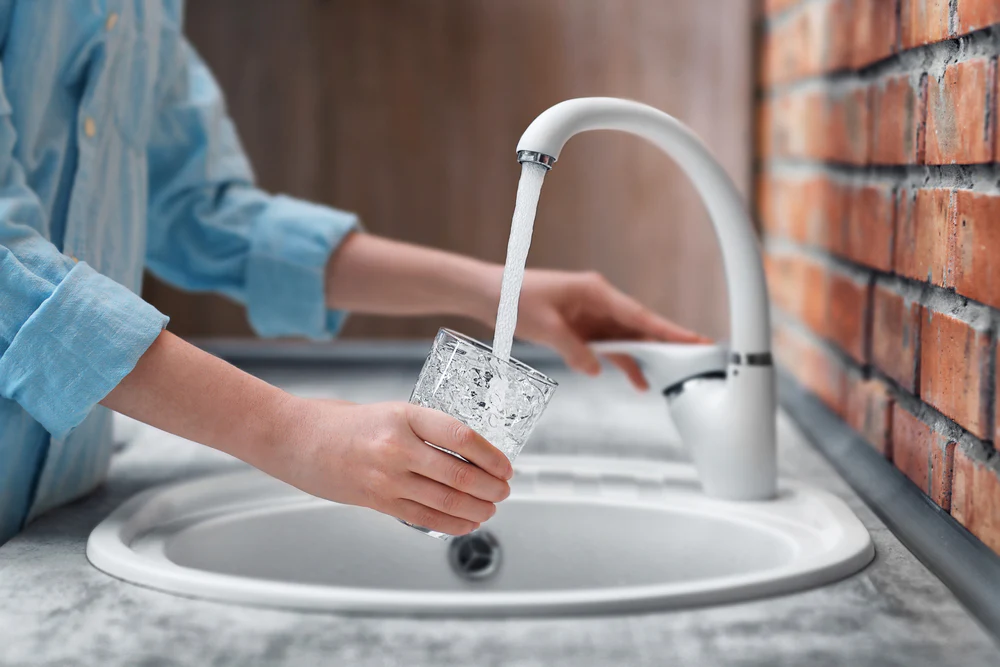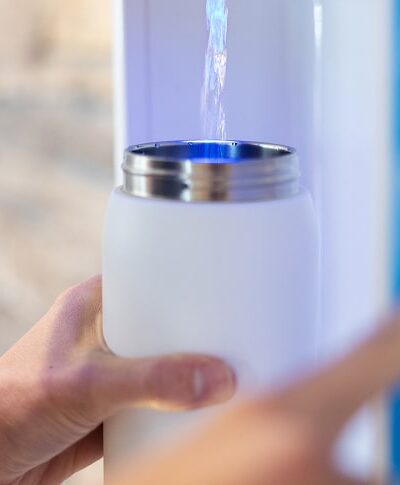Knowing how to test water quality is important for all businesses that have remained unopened during the pandemic shutdowns. The spread of COVID-19 halted business operations as people began to shelter-at-home. Even as companies start to resume in-person activities, the closing of schools, restaurants, gyms, and other places of business have resulted in stagnant water in pipes for months.
Standing water for a long period of time may contain excessive amounts of heavy metals and pathogens, according to the National Science Foundation, increasing the need for water quality testing. Although water source treatment plants typically add small amounts of disinfectant to their public water supply in order to prevent bacteria growth, these chemicals degrade in stagnant water. Furthermore, when systems aren’t flushed, and fresh water isn’t introduced into the system regularly, these disinfectants are less effective.
Many businesses remain closed, which means a further extension of water systems going unused before returning people back to businesses. Prior to reopening, it’ll take several steps past the performance of a water quality test to ensure water quality is up to par. To eliminate stagnant water and improve water quality to make it safe for guests and customers, here are six steps to follow and cleaning standards to uphold.
Perform Regular Water Quality Testing
At a minimum, water testing on the location of your source water should be performed on an annual basis. Every year, each city’s community water supplier, responsible for local water utility, must provide an annual Consumer Confidence Report (CCR) that gives information regarding contaminants’ presence and level in tap water. This water quality report must display results that adhere to the Environmental Protection Agency’s set standards for the presence and levels of over 90 potential contaminants, including heavy metals, fecal coliform bacteria, and salmonella found in drinking water.
However, aging plumbing systems or unprecedented events like a virus outbreak introduce extra challenges that may require you to conduct a water test more frequently to ensure tap water is safe to drink. Due to the buildup of stagnant water over the past several months, new bacteria and heavy metal accumulation are likely to have formed, therefore, skewing normal testing data. Since the CCR is distributed once a year, near July, whatever happens after or before the next testing may differ significantly depending on the current environment.
County health departments or a state-certified environmental laboratory know how to test water quality. If your system shows a higher amount of a contaminant, systems must be cleaned and retested until the elevated levels meet regulation. Businesses concerned with decreased water quality should request testing and/or establish thorough sanitization protocols before opening.
Maintain the Correct Temperature for Your Water Heater
In addition to stagnant water, the wrong water temperature can lead to bacterial growth, including the potential for Legionnaires’ disease. Per the Occupational Safety & Health Administration (OSHA), water heaters should be set to at least 140 degrees Fahrenheit (60 degrees Celsius) to minimize the growth of Legionella and other bacteria.
Water conditions that promote Legionella’s growth include stagnation, temperatures between 20 and 50 degrees Celsius, pH levels between 5.0 and 8.5, and sediment and volatile organic compounds that encourage bacteria growth. Ongoing maintenance to ensure water tank temperature and eliminate areas of stagnant is important to prevent breeding grounds.
Scheduled inspections to maintain water temperature is essential, even more so when the building has been subjected to stagnant water for months at a time due to Covid-19. OSHA recommends raising the water-heater temperature to a minimum of 158 degrees Fahrenheit for 24 hours and flushing all outlets for 20 minutes.
Flush the Water System and Assess for Mold
An important step when learning how to test water quality is detecting mold and flushing the system. With the prolonged shutdowns, resuming operations must include a water assessment for mold and excess moisture in the building water system, including HVAC systems, prior to people returning to the building. Contaminated water can cause harmful effects if people drink it, but also if it’s inhaled through droplets in the air, such as distributed through air-conditioning units.
The purpose of flushing the water system is to replace all stagnant water inside the pipes with fresh water. This must be conducted for all hot and cold water at all points of use throughout the building. There’s a “flush out” period identified by the Centers for Disease Control and Prevention (CDC) that requires operation for at least a 48 to 72 period of time to assess mold growth. This should be conducted by trained industrial inspectors who can recognize the presence of mold by sight or odor and take the proper steps to remove both.
Clean and Disinfect All Water Fountains Consistently
Following flushing the water system, all water fountains and water refilling stations should be cleaned and disinfected to rid surfaces of built-up grime. These must be continuously cleaned after use to prevent the spread of germs due to frequent contact. It’s also important to ensure water fountains are in good working order. Older systems may have lead and other chemical contaminants that leach into the water, making it unsafe to drink.
Due to Covid-19, many businesses have opted to replace water fountains with hydration stations, such as FloWater, to provide contactless or limited contact options. This is valuable for employees as well as guests of the business. It also reduces the amount of maintenance necessary for cleaning and disinfecting. It allows people to refill their personal water bottles or jugs with fresh, purified water from a system designed to limit dirt, grime, and germs.
Evaluate Hot Tubs and Spas for Safe Use
Hot tubs and spas are notorious for breeding bacteria and must be checked for film or slime on a regular basis. There are several steps before they can be deemed adequately safe for use. The CDC provides disinfection guidelines to ensure water quality. First, shut down the pumps and collect a water sample for testing by the health department. Next, drain all water from the hot tub and scrub all surfaces and components with fresh water with free chlorine at a minimum concentration of five parts per million.
Rinse with clean water and flush. Replace filters and inspect for any needed repairs to the valves, sensors, or other hot tub or spa parts. Finally, refill with hyperchlorinated water using 20 parts per million free chlorine and allow the water to circulate for an hour before turning the jets on and allow it to continue circulating for nine additional hours.
Flush the entire system and take new samples to confirm the elimination of bacteria and mold. Once the water test result proves negative, ensure pH levels and water quality to meet state standards before reopening the hot tub for use.
Keep Cooling Towers Sanitized
Cooling towers use a fan to move air through a recirculated water system, which means a significant amount of water vapor is introduced to the surrounding environment. Since Legionnaires’ disease transmission primarily occurs through the consumption of water that suffers from bacterial contamination, it’s imperative to maintain cleanliness and sanitation of cooling towers at least twice a year and prior to resuming operations following COVID-related shutdowns.
As with water fountains and hot tubs, part of the steps necessary to test water quality involves ensuring cooling towers are clean and free from slime and debris prior to use. This includes testing water, flushing, and retesting to confirm the water is free from bacteria. Other treatment approaches involve eliminating stagnant water areas, maintaining the system’s cleanliness, and identifying leaks in the system.
The same sanitization treatment is necessary for safety equipment, such as sprinkler systems and eye wash stations. These should be regularly flushed, clean, and disinfected per manufacturers’ specifications as well.
Cleaning Standards to Follow Before and After Water Testing
Cleaning and disinfecting surfaces are as important as testing the water itself. When cleaning water fountains, sinks, and other areas that come into contact with contaminated water, in addition to everyday germs and bacteria, it’s important for people to wear proper safety protection to avoid exposure.
The CDC recommends wearing skin and eye protection to avoid potential splash or inhalation. It’s also best to have the cleaning area properly ventilated. Use water at room temperature for dilution and never use more than the recommended amount on the label or mix cleaning products. By taking proper precautions and implementing a routine of water testing and maintenance, this helps prevent the presence of Legionella and other bacteria from growing in the water systems and being distributed throughout your place of business.
Benefit from a Self-Sanitization, Contactless Filtered Water Station
The reopening process has been challenging due to the various constraints that have been caused by Covid-19. New sanitization and spacing protocols are necessary to prevent the spread of the virus. Plus, buildings that haven’t had occupancy for months at a time face the risk of stagnant water in the pipes. This may be an ongoing problem as certain states remain on the cusp of closure again, and there’s no prediction of what capacity a building may operate.
Knowing how to test drinking water quality and what cleaning and sanitization steps to take is necessary to ensure that when people resume in-person operations, the water system is safe to use. FloWater provides an extra level of cleanliness via its hydration station design and water treatment quality through its advanced filtration process. The station’s surface requires minimal maintenance for cleanliness. It has self-sanitization tanks and a hidden catchment tray to reduce the buildup of grime and germs. Now, with the addition of the foot pedal component, it also offers a no-touch solution to refill any size water container.
The advanced purification process transforms water from the tap to remove up to 99 percent of all contaminants found in the water, including harmful bacteria, chemicals, and heavy metals. The result is safe drinking water available and a filter that typically requires only a once-a-year replacement. The advantage of having a self-sanitizing, contactless, filtered water station is a sustainable solution for businesses at whatever stage of operation they’re experiencing.
Sources:
- https://www.nsf.gov/discoveries/disc_summ.jsp?cntn_id=300435&org=NSF
- https://news.stlpublicradio.org/health-science-environment/2020-06-09/as-buildings-reopen-stagnant-water-may-harbor-unseen-risks
- https://www.cdc.gov/healthywater/drinking/public/water_quality.html#testing
- https://www.epa.gov/sites/production/files/2015-11/documents/2005_09_14_faq_fs_homewatertesting.pdf
- https://www.osha.gov/dts/osta/otm/otm_iii/otm_iii_7.html
- https://www.cdc.gov/coronavirus/2019-ncov/php/building-water-system.html




